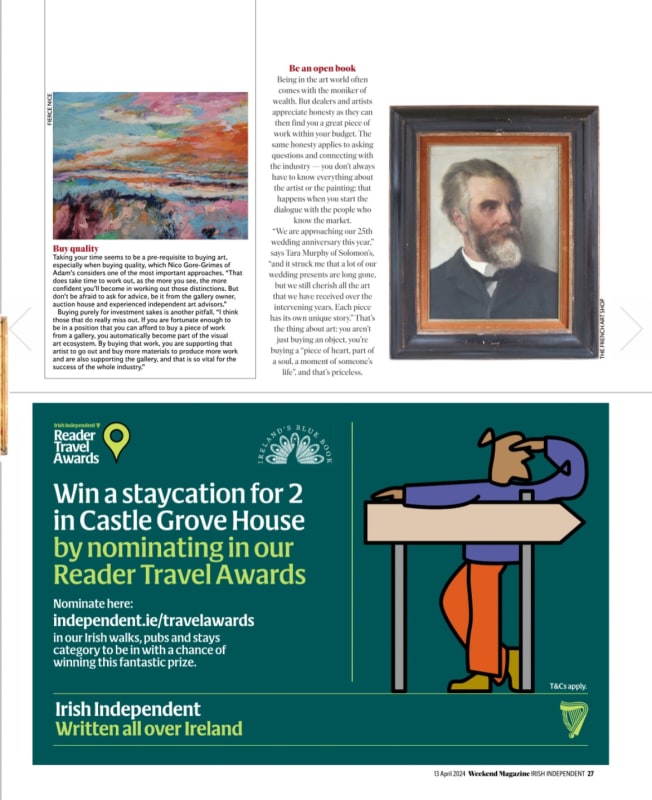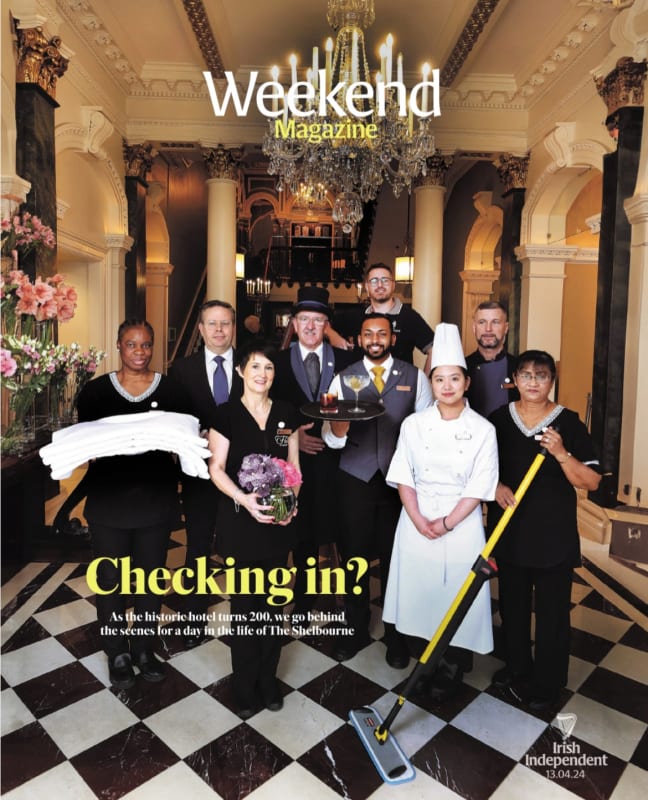"Always check the back of a canvas and don't follow trends".
For novices, the art world may seem like an elitist bubble filled with celebrities and Saudi royals who can drop a cool few million without so much as a glance at their bank balance.
There is often the assumption that you must possess an expendable income and a thorough knowledge to choose the "right" piece at the "right" price. Not to mention the potentially intimidating setting of an auction house or gallery, and the variability of prices, which can rise overnight based on market sales.
It can be easy to feel excluded and put off by the idea of buying art. But you don't need an art history degree or deep pockets to make your first purchase.
Take New Yorkers Herbert and Dorothy Vogel a postman and a librarian respectively, who amassed pieces including works by Picasso and Lichtenstein that they managed to exhibit in their tiny Manhattan apartment, a collection that is considered "priceless", proving passion is often the key to owning an enviable range of artworks.
But where do you begin? And what should you look for? It can help to arm yourself with some expert advice.
Do your research
It doesn't really start with collecting, but browsing, a lot. A work that catches your eye initially may get tiresome after a while. "Starting a collection can be daunting", says Tara Murphy, owner of Solomon Fine Art Gallery in Dublin. "There are so many artists and so many galleries, it can be overwhelming".
She suggests starting with the Contemporary Art Gallery Association website, caga.ie, which encompasses the 10 main galleries in Dublin. Each gallery has a rough house style - figurative, abstract, landscape etc - and you may find yourself drawn to one gallery or artist over another, she says. Once you have a shortlist of favourites , go and visit the gallery in person and consider group shows which are often a great way to see a gallery's whole "stable" in one visit.
Director at Adam's Fine Art Auctioneers Nico Gore-Grimes agrees. “If I was starting out again, I’d probably go to as many galleries as possible,” he says. He also advises getting to auctions, which has never been easier with online platforms.
“When I started out with Adam’s 30 years ago, the auction rooms were packed with people bidding. Now we have auctions on multiple platforms so our reach internationally is considerable.” It also throws the net wider for people who may not get there in person, so they have access to a huge pool of artists from the comfort of their own home.
The more research you do, the better your ‘eye’. “One of my biggest bugbears is hearing collectors boast that they have bought a well-known ‘name’ at auction at a bargain price. But artists have off days, like anyone else, so there can be some ‘bad’ artworks out there,” says Murphy.
It’s important to look and train your eye. “Or at least seek professional advice to help guide you in the right direction (or stop you from buying poor examples by an artist of note).”
The easiest way to do that is see as much as you can: go to exhibitions, galleries, fairs, browse online, visit student degree shows and talk to those in the know. Once you know what you like, you can decide how much you want to spend. Drawings and prints tend to be cheaper than paintings or sculptures.
Whether you’ve deep pockets or not, the rule of thumb for buying art is to choose what you love.
Authenticity and condition
“Always request condition reports,” advises Nico Gore-Grimes from Adam’s, which are free and prepared as a matter of course by auctioneers or vendors. If the work is expensive, ask to see the back and check for marks on the canvas or board that might suggest a repair. Look for mould or mildew with works on paper.
“The good news is we have wonderful conservators here in Ireland so something [like] that can always be restored,” says Tara Murphy of Solomon’s, but it’s worth asking the gallerist or artist if there’s a recommended way of presenting the artwork once you get it home. Works on paper, for example, if hanging in a room with direct sunlight, should be framed under UV-filtered glass, and hanging art directly over a hot radiator isn’t advised.
These days, provenance is easily traced. You can check if the artist has any works in private or public collections such as the Office of Public Works State Art Collection or the Arts Council, whether they’ve won any awards or are represented in any galleries which might add some kudos to your investment.
Make sure you love it
Following the market is important but much of buying art is about trusting your gut. Value very often has nothing to do with what’s ‘hot’; trends will come and go and you might regret buying something because it’s a commodity.
The question is, how does it make me feel? How will I feel surrounded by it every day? Works of art are a bit like people — if you don’t like them, then don’t have them in your house. I always think there’s something thrilling about finding a picture at a flea market for €100 that makes your heart sing; it’s like having a secret.
British artist Ben Nicholson suggests people hang a picture on their wall and “eat their meals with their back to it for a month”. Only then would they know how they really felt about it and its ability to surprise. If, in years to come, it’s appreciated in value, then that’s an added bonus.
Buy quality
Taking your time seems to be a pre-requisite to buying art, especially when buying quality, which Nico Gore-Grimes of Adam’s considers one of the most important approaches. “That does take time to work out, as the more you see, the more confident you’ll become in working out those distinctions. But don’t be afraid to ask for advice, be it from the gallery owner, auction house and experienced independent art advisors.”
Buying purely for investment sakes is another pitfall. “I think those that do really miss out. If you are fortunate enough to be in a position that you can afford to buy a piece of work from a gallery, you automatically become part of the visual art ecosystem. By buying that work, you are supporting that artist to go out and buy more materials to produce more work and are also supporting the gallery, and that is so vital for the success of the whole industry.”
Be an open book
Being in the art world often comes with the moniker of wealth. But dealers and artists appreciate honesty as they can then find you a great piece of work within your budget. The same honesty applies to asking questions and connecting with the industry — you don’t always have to know everything about the artist or the painting; that happens when you start the dialogue with the people who know the market.
“We are approaching our 25th wedding anniversary this year,” says Tara Murphy of Solomon’s, “and it struck me that a lot of our wedding presents are long gone, but we still cherish all the art that we have received over the intervening years. Each piece has its own unique story.” That’s the thing about art: you aren’t just buying an object, you’re buying a “piece of heart, part of a soul, a moment of someone’s life”, and that’s priceless.


